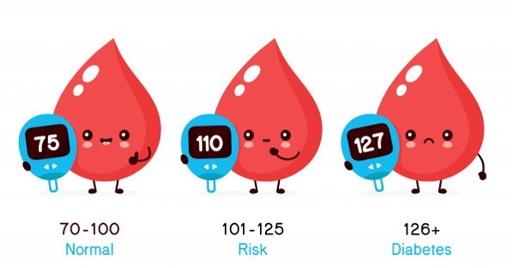Prediabetes
Diabetes can be a very deceptive disease. It can be present with almost no warning signs. However, there are a few symptoms that may indicate that it is present. Because of its tendency to operate in silence, its damage is being performed and you never even know it is there.
Some people are referred to as having prediabetes or borderline diabetes when blood sugar is usually in the range of 100 to 125 milligrams per deciliter (mg/dL). Normal blood sugar levels sit between 70 and 99 mg/dL, whereas a person with diabetes will have a fasting blood sugar higher than 126 mg/dL.
The prediabetes level means that blood glucose is higher than usual but not so high as to constitute diabetes. People with prediabetes are, however, at risk of developing type 2 diabetes, although they do not usually experience the symptoms of full diabetes.
Risk factors
The risk factors for prediabetes and type 2 diabetes are similar. They include:
- being overweight / Obese
- a family history of diabetes
- have high blood pressure, high cholesterol, or high triglycerides or having a high-density lipoprotein (HDL) cholesterol level lower than 40 mg/dL or 50 mg/dL
- having gestational diabetes or giving birth to a child with a birth weight of more than 9 pounds
- a history of polycystic ovary syndrome (PCOS)
- being more than 45 years of age
- having a sedentary lifestyle
- Genetic defects such as in insulin processing or insulin action, or in Mitochondrial DNA mutations
- Exocrine pancreatic defects such as Chronic pancreatitis (inflammation of the pancreas), Pancreatic neoplasia, Cystic fibrosis
- Disorders with the Endocrine System such as Growth hormone excess (acromegaly, Hyperthyroidism, Hypothyroidism
- being of African-American, Native American, Latin American, or Asian-Pacific Islander descent

Signs and Symptoms you may be having Diabetes
Do take into consideration that some people who have diabetes never show any signs of these symptoms, so looking for them may not be the only reason to suspect you might have it. Some basic symptoms that may occur include: -
- Need to urinate frequently - may be one of the first indications that your blood sugar levels are too high. This happens because your body is pulling liquids out of various places to cause you to urinate the excess sugars out of your system. You will probably notice that you need to urinate more frequently when you eat foods with high sugar levels, such as soda and deserts.
- Constant hunger or excessive thirst - If you are thirstier than usual then it is because you are losing fluids faster, you become thirstier than normal with diabetes. This is because the liquid you are losing through urination needs to be replaced. You may also be constantly hungry as there is a need for sugar and energy. Since the body may not be getting the energy it needs, it makes you hungry so that it can get more.
- Extreme fatigue - Feeling tired is the result of energy from the sugar not being transferred successfully to where it is needed. Your body needs the energy from sugar to perform all its operations and muscle movements. Diabetes, or even prediabetes, can cause you to become drained of energy and tiredness settles in.
- Unexplained or possible rapid weight loss – Weight loss may occur rather rapidly if you have Type I diabetes. This form of diabetes can go after energy that is stored in your muscles and other body tissues. This can cause a rather rapid loss of weight without even trying.
- Cuts and wounds that are slow to heal - When you have sores that do not heal as fast as they normally do, this could be evidence of diabetes.
- Numbness or burning sensations in hands/feet - You may also have a tingling or numbness (pins and needles), in your hands, arms, legs and feet, which could be the result of having too much sugar in the blood for a long time. Do watch out for loss of feeling in the feet, tingling or burning sensation, Muscle weakness as well.
- Neuropathy, or damage to the nerves are due to the high blood glucose which damages nerves in the arms, hands, legs and feet.
- Diabetic eye disease affects the blood vessels in the retina. Watch out for: Blurred vision (Eye sight becoming blur), Seeing floating spots or shadows or Having trouble seeing at night. Blurred vision usually occurs as the changing fluid levels in your body could make the lenses in your eyes swell up. They change shape and can’t focus.
- Dry mouth and itchy skin. Because your body is using fluids to make pee, there is less moisture for other things. You could get dehydrated, and your mouth may feel dry. Dry skin can make you itchy.

Prevention
Diabetes may not be prevented in all cases. Type 1 diabetes cannot be prevented. You may be able to reduce your chances for developing type 2 diabetes by managing your diet and staying active. However, genetics and other risk factors may increase your risk despite your best effort. Even if you have a diagnosis of diabetes, you can live a full life. Diabetes requires careful planning and management, but it shouldn’t prevent you from engaging in and enjoying everyday activities.
- Maintaining a normal body weight. Being overweight has been determined to be the primary cause of diabetes, and removing the excess weight is one of the primary things you can do to reduce the threat and possibly delay the disease. The amount of weight that needs to be lost for most people is somewhere around 8 to 10 pounds. Reducing your weight often begins with your diet.
- Eating and Maintaining a healthy diet is the most effective way to control your weight. For many people, this is a new way of life, and the best way to achieve it will be to start some kind of journal to record your calorie intake. When you start keeping track of your calorie intake you may be shocked and surprised at just how many calories you do eat in a day.
Be sure to keep track of everything, including any snacks, deserts, regular meals, as well as all drinks. By the time all that gets added in, it really adds up. Dietary changes known to be effective in helping to prevent diabetes include maintaining a diet rich in whole grains and fiber (fruits, vegetables), lean proteins and choosing good fats, such as the polyunsaturated fats found in nuts, vegetable oils, and fish. Limiting sugary beverages, fast foods, processed/prepackaged foods, eating less red meat and other sources of saturated fat (all which contains a large amount of calories and excess sugar), can also help prevent diabetes.
- Engaging in physical activity (Exercise regularly). Engaging in at least 30 minutes exercise a day on at least 5 days of the week, such as of walking, aerobics, riding a bike, or swimming. This will not only help you lose the weight, but it will also create good overall health and help you feel better, too. Higher levels of physical activity (more than 90 minutes per day) may reduce the risk of diabetes by 28%.
- Refraining from drinking excessive amounts of alcohol or keeping intake to less than one drink a day for women or two drinks a day for men.
- Tobacco smoking is also associated with an increased risk of diabetes and its complications, so smoking cessation can be an important preventive measure as well.
Diabetes is a disease that can often be prevented. The most important thing that you can do is to lose the extra weight and start eating a healthy diet. Some lifestyle changes will be needed rather quickly. These changes involve what you eat and how, getting regular exercise, and developing and maintaining a more active lifestyle.
Learn more how Hi-Bliss Hydrogen Therapy can help with Metabolic Syndrome diseases such as Diabetes here: https://wordpress-851564-2937612.cloudwaysapps.com/treatment-services-detox-wellness/
References:-
- Molecular Hydrogen Improves Obesity and Diabetes by Inducing Hepatic FGF21 and Stimulating Energy Metabolism in db/db Mice ~ Naomi Kamimura, Ikuroh Ohsawa, Shigeo Ohta et.al. www.obesityjournal.org. doi:10.1038/oby.2011.6
- The Effects of 24-Week, High-Concentration Hydrogen-Rich Water on Body Composition, Blood Lipid Profiles and Inflammation Biomarkers in Men and Women with Metabolic Syndrome: A Randomized Controlled Trial ~ Tyler W LeBaron, Sergej M Ostojic et.al. Diabetes, Metabolic Syndrome and Obesity: Targets and Therapy. doi.org/10.2147/DMSO.S240122
- Hydrogen Therapy in Cardiovascular and Metabolic Diseases: from Bench to Bedside ~ Yaxing Zhanga Sihua Tana Jingting Xuc Tinghuai Wang. Cellular Physiology and Biochemistry. DOI: 10.1159/000489737



